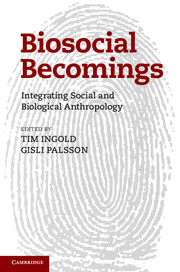Book contents
- Frontmatter
- Contents
- Preface
- 1 Prospect
- 2 Ensembles of biosocial relations
- 3 Blurring the biological and social in human becomings
- 4 Life-in-the-making: epigenesis, biocultural environments and human becomings
- 5 Thalassaemic lives as stories of becoming: mediated biologies and genetic (un)certainties
- 6 Shedding our selves: perspectivism, the bounded subject and the nature–culture divide
- 7 Reflections on a collective brain at work: one week in the working life of an NGO team in urban Morocco
- 8 The habits of water: marginality and the sacralization of non-humans in North-Eastern Ghana
- 9 ‘Bringing wood to life’: lines, flows and materials in a Swazi sawmill
- 10 Humanity and life as the perpetual maintenance of specific efforts: a reappraisal of animism
- 11 Ravelling/unravelling: being-in-the-world and falling-out-of-the-world
- 12 Retrospect
- References
- Notes on the contributors
- Index
4 - Life-in-the-making: epigenesis, biocultural environments and human becomings
Published online by Cambridge University Press: 05 June 2014
- Frontmatter
- Contents
- Preface
- 1 Prospect
- 2 Ensembles of biosocial relations
- 3 Blurring the biological and social in human becomings
- 4 Life-in-the-making: epigenesis, biocultural environments and human becomings
- 5 Thalassaemic lives as stories of becoming: mediated biologies and genetic (un)certainties
- 6 Shedding our selves: perspectivism, the bounded subject and the nature–culture divide
- 7 Reflections on a collective brain at work: one week in the working life of an NGO team in urban Morocco
- 8 The habits of water: marginality and the sacralization of non-humans in North-Eastern Ghana
- 9 ‘Bringing wood to life’: lines, flows and materials in a Swazi sawmill
- 10 Humanity and life as the perpetual maintenance of specific efforts: a reappraisal of animism
- 11 Ravelling/unravelling: being-in-the-world and falling-out-of-the-world
- 12 Retrospect
- References
- Notes on the contributors
- Index
Summary
In my opinion the greatest error which I have committed, has been not allowing sufficient weight to the direct action of the environment, i.e. food, climate, &c., independently of natural selection. … When I wrote the ‘Origin’, and for some years afterwards, I could find little good evidence of the direct action of the environment; now there is a large body of evidence.
Charles Darwin to Moritz Wagner, 1876 (in Darwin 1887: vol. 3, 158)From genomics to epigenomics: epistemic and theoretical shifts
When Mendel’s experiments and theories were rediscovered by Hugo de Vries (1848–1935), Darwinian evolutionary theory merged with genetics in what J. S. Huxley called the New synthesis and Romanes neo-Darwinism, because of its insistence on the primacy of natural selection. Instead of concentrating on organisms and their evolution, the new evolutionary theory was interested in genes as structural units of inheritance, selection and evolution. Genes were first defined by Johannsen in 1909 (Johannsen, 1909: 124, in Gerstein et al. 2007). They became the units of heredity (Noble 2010) and evolution, credited with carrying the instructions for building phenotypes from genotypes. Gene-centred evolutionary theories reduced biology to genetics and with that, life evaporated from biology (Ingold 1990). Neither the shift from focusing on individuals to focusing on populations (Dobzhansky, 1951 [1937]), nor the identification of genes with molecules of DNA (Watson and Crick 1953) changed the inherent genetic fetishism of neo-Darwinism. It was rather reinforced.
- Type
- Chapter
- Information
- Biosocial BecomingsIntegrating Social and Biological Anthropology, pp. 59 - 83Publisher: Cambridge University PressPrint publication year: 2013
- 9
- Cited by

